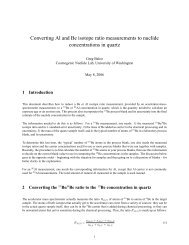Be exposure age calculator MATLAB function reference Version 2
Be exposure age calculator MATLAB function reference Version 2
Be exposure age calculator MATLAB function reference Version 2
Create successful ePaper yourself
Turn your PDF publications into a flip-book with our unique Google optimized e-Paper software.
[<br />
]<br />
N trap = s 2<br />
e −(λ+ Λ)(T ɛ +s) + e −(λ+ Λ)T ɛ (12)<br />
[ ]<br />
s<br />
= ɛ 2 e−(λ+ Λ)T<br />
e −(λ+ Λ)s ɛ + 1<br />
(13)<br />
So the ratio of the approximate to true nuclide concentration is:<br />
N trap<br />
= − s ( [<br />
]<br />
)<br />
λ + ɛ e −(λ+ Λ)s ɛ + 1<br />
Λ<br />
[<br />
] (14)<br />
N actual 2 e −(λ+ Λ)s ɛ − 1<br />
Several things are important here. First, this does not depend on T , so it represents the accuracy of the approximation<br />
for the entire integration as well as for a single time step. Second, this is always greater than 1, that is, trapezoidal<br />
integration always overestimates the nuclide concentration – which eventually results in an underestimate of the <strong>exposure</strong><br />
<strong>age</strong>. Although this is accounted for by the fact that <strong>reference</strong> production rates are calibrated using the same<br />
numerical method that is used for the <strong>exposure</strong> <strong>age</strong> calculations, it is still important to minimize this inaccuracy. Third,<br />
the spallogenic part of the production-depth relationship is the limiting factor in selecting the time step – production<br />
by muons can be considered just to have larger Λ, which is always more accurate for the same s.<br />
In practice, for an erosion rate of 10 m · Myr −1 , that is, 0.001 cm · yr −1 , which would be considered large for accurate<br />
<strong>exposure</strong> dating, the 1000-yr time step used in the calculation yields accuracy at the 10 −5 level, which is clearly<br />
adequate for the present purpose. Note that it would not be acceptable for short-half-life radionuclides (e.g., 14 C) or<br />
high erosion rates.<br />
4. Check for saturation.<br />
If the measured nuclide concentration in the sample exceeds the highest calculated value of N Xx (t) for a particular<br />
scaling scheme, the sample is taken to be saturated with respect to that scaling scheme. As discussed above, the choice<br />
of the maximum length of the forward calculation means that this determination is conservative, that is, samples that<br />
are in reality close to saturation may be reported as saturated. Again, if you are interested in rigorous analysis of<br />
near-saturated samples, this code is not for you.<br />
5. Error propagation.<br />
We approximate the uncertainty in the <strong>exposure</strong> <strong>age</strong> results by solving the simple <strong>age</strong> equation for an effective scaling<br />
factor S eff,Xx for each scaling scheme Xx. This is the scaling factor that, when used in the simple <strong>age</strong> equation, yields<br />
the actual <strong>exposure</strong> <strong>age</strong> inferred from the full forward integration described above. Then the effective production rate<br />
P eff,Xx = P ref,Xx · S eff,Xx · S thick · S G . This then allows linear propagation of errors through the simple <strong>age</strong><br />
equation to arrive at an estimate of the <strong>age</strong> uncertainty, as follows.<br />
The internal uncertainty in the <strong>exposure</strong> <strong>age</strong> σ int t Xx for scaling scheme Xx is:<br />
(σ int t Xx ) 2 =<br />
(<br />
∂tXx<br />
∂N<br />
) 2<br />
σN 2 (15)<br />
where σN is the standard error in the measured nuclide concentration and:<br />
[<br />
(<br />
∂t Xx<br />
∂N = P eff,Xx − N λ + ρɛ )] −1<br />
(16)<br />
Λ sp<br />
12



